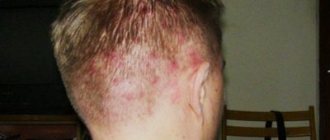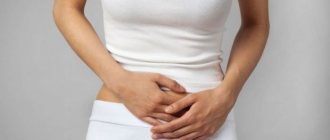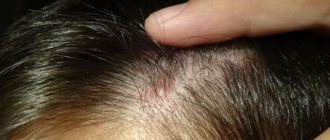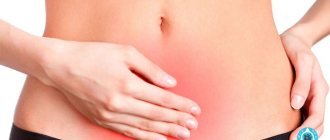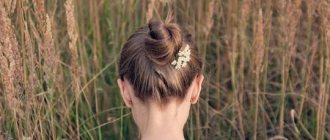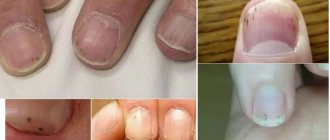Pimples on the scalp in the hair are a very common occurrence. Unfortunately, it is usually not given importance, since the rashes are hidden behind the strands. As a rule, the patient turns to a specialist only when the problem becomes widespread. However, it should be remembered that treatment in this case turns out to be much more complex and lengthy.
General information
The appearance of acne on any part of the body is not only a cosmetic problem, but also a medical problem.
As a rule, acne on the scalp under the hair appears due to the same reasons as on other parts of the body. However, their development is also provoked by other factors, such as too infrequent or, conversely, very frequent hair washing. That is why it is very important to teach a child to treat personal hygiene issues correctly from childhood. More often, such formations on the skin appear in men, but women can also periodically notice such formations.
Sometimes, in order to get rid of such manifestations, it is enough just to adjust your lifestyle, approach to nutrition and hygiene. When acne appears on the scalp or on the back of the head, in some cases it is advisable to use medications.
More details about the reasons for the appearance of such formations, as well as possible methods of treatment, will be discussed in this article.
Additional recommendations
For men
- In men, a rash can appear due to shaving bald, due to damage to the skin during the procedure and the further development of pathogenic microflora in microcracks.
- Often, acne in the stronger sex occurs due to the constant wearing of hats - caps or caps.
- A change in the amount of testosterone in the blood can provoke skin problems of any nature.
- Well, alcohol abuse and smoking are also common causes of purulent rashes in men. You need to eliminate them first, and only then begin treatment.
Women
In women, the disease can be triggered by unstable hormonal levels associated with menstrual irregularities. This leads to an increase in testosterone levels. If we look at the problem even deeper, polycystic ovary syndrome can also provoke rashes. Such diseases must be treated strictly by a specialist.
Classification
Acne on the scalp is divided into several types depending on the characteristics of the pathological process:
- Comedones - such formations appear due to blockage of skin pores due to too high activity of the sebaceous glands. These formations do not cause pain, but can develop into pimples over time. They can be both external and internal.
- Acne - these rashes are accompanied by an inflammatory process. These are small red bumps, in the center of which there may be a white pustule. They are painful and may itch.
- Purulent acne - in the absence of proper treatment, ordinary acne turns into purulent acne. In the center of such a formation there is a purulent core.
- Infectious acne - can be a symptom of viral infectious diseases. With such formations, the temperature may rise, weakness, and headache may appear.
What types are most common?
The following types of rashes are often observed on the head:
- Purulent (at first small, then increasing in size, when pressed, pus comes out - indicate bacterial inflammatory processes).
- Red, small (often transforms into ulcers, which indicates viral infections).
- Painful white ones (they can be accompanied by unpleasant symptoms such as itching and burning, and are associated with deeper damage to the skin). The rash may indicate the development of herpes or shingles.
- Subcutaneous comedones (occur due to clogged pores).
Causes
Speaking about why acne appears on the head under the hair, it should be noted that very often such formations on the skin indicate problems with the skin.
The reasons why purulent pimples or ordinary comedones appear on the head in the hair may be as follows:
- Unbalanced and irrational nutrition. Pimples on the skin and on the back of the head can periodically appear in those who abuse too much fatty, salty foods, fast food, and sweets.
- Using unsuitable scalp and hair care products. If shampoo or any other cosmetic product is used, allergic reactions may subsequently develop and the acid-base balance may be disrupted. As a result, the sebaceous glands begin to work incorrectly, which leads to dandruff, acne, hair loss, etc.
- Wrong approach to hygiene procedures. Washing your hair too often can damage the skin's protective properties. It becomes vulnerable to pathogens. This also happens when you use a hairdryer too often. However, washing your hair insufficiently often also leads to pathological manifestations on the skin.
- Diseases and pathological conditions. A number of diseases can provoke regular and purulent acne. If acne appears on the head, the cause may be a dysfunction of the gastrointestinal tract, adrenal glands, fungal, parasitic and bacterial infections, etc.
- Hormonal disorders. Such formations on the head of women sometimes appear with polycystic ovary syndrome , during menopause and other conditions caused by hormonal imbalance. This sometimes happens in adolescence.
- Diseases of the nervous system, prolonged stress. Sometimes acne in the hair is a consequence of psychological disorders. During stressful situations, active production of cortisol and androgens , which provoke the development of comedones.
- Scalp problems. Pimples on the head in the hair of men and women appear with seborrhea , hyperkeratosis , hyperplasia of the sebaceous glands.
- Taking medications. Formations on the back of the head and in the hair can appear when taking hormonal medications, barbiturates, etc.
- Allergic reactions. In an infant, a similar symptom may be associated with manifestations of allergies . If such a formation hurts, the baby may behave restlessly.
- Mechanical damage and injury. The formations appear as a result of scratching the head, injuries, etc.
- Bad habits.
How to treat acne on the head
You can only get rid of such a problem as acne on the head in the hair by identifying and eliminating its cause. Experts advise starting with external factors (namely proper washing of the hair and scalp), as well as correcting the diet.
You should wash your hair as it gets dirty, but at least once every 7-10 days. Doing this too often can cause your sebaceous glands to become overactive, which can lead to acne. Washing your hair daily is also acceptable, for example, if you are involved in active sports and sweat a lot. In this case, it is recommended to use a special shampoo. It differs from the usual one in its gentle composition. To keep your hair fresh longer, it is advisable to wash it in the morning - the peak of sebum secretion occurs at this time. Too hot water stimulates the production of sebum - it is better to use warm water. Rinse off shampoo twice as long as it takes to apply it. If you rush, particles of detergent will remain on the scalp, which will cause inflammation.
When choosing a cleanser, focus on your scalp and hair type. If, after washing your hair, you feel discomfort, for example, itching, tightness, or flaking skin, shampoo is not suitable for you. If you have acne, you can also try a medicated shampoo. It is advisable to select it together with a trichologist or dermatologist. These products are based on active ingredients that destroy harmful bacteria and control the functioning of the sebaceous glands.
- Shampoos with selenium disulfide . They have an antibacterial effect and reduce the activity of the sebaceous glands.
- Shampoos based on antifungal components. They can be useful at the initial stage of acne development and only if the cause of the rash is bacteria.
- Shampoos with zinc. Act as antiseptics and antifungals, regulate the functioning of the sebaceous glands on the scalp. Such remedies are especially effective when acne is caused by an allergic reaction.
“Regardless of the underlying cause of the disease identified as a result of medical diagnosis, it is recommended to normalize the diet,” says our expert. “You should limit your intake of salty, fatty and sweet foods, consume enough fiber and foods rich in vitamins, calcium, selenium and zinc, omega-3 saturated fatty acids, and avoid foods with preservatives.”
Symptoms
Typically, scalp acne forms along the hairline. These are small growths that may itch or hurt. As the pathological process develops, pustules, papules, and nodules may appear on the skin. The size of such formations varies - from 1 mm to 1 cm.
Inflammatory formations are red and have purulent inclusions. They itch, hurt, and are easily damaged when scratched. As a result, the infectious process can spread.
Hair loss in this case does not always occur. However, squeezing pimples on your own sometimes leads to scarring or the spread of infection, which in turn causes hair loss.
Medicines
If adjusting your scalp and hair care does not solve the problem, a specialist may prescribe pharmaceuticals for external and/or internal use.
- Products for external use. Ointments, lotions, gels, solutions with antibacterial, antimicrobial, anti-inflammatory, antipruritic, drying effects. The main active ingredients of such drugs, as a rule, are: gentamicin, synthomycin (chloramphenicol), salicylic acid, ichthyol (ichthammol), zinc, erythromycin, mirrorin, retinoids. Such products are used in a course and applied pointwise to the affected areas of the skin. Before starting use, you should do an allergy test by applying a small amount to the skin behind the ear.
- Systemic antibiotics. Since they have a more pronounced effect, they are prescribed when the disease becomes protracted and widespread. Antibiotics can be local or systemic (for oral administration). Such drugs also differ in their mechanism of action: they are divided into bactericidal and bacteriostatic. The first ones destroy microorganisms, the second ones inhibit their growth and reproduction. For the treatment of acne, medications based on penicillin, erythromycin, tetracycline, and lincomycin are prescribed. They accumulate well in the sebaceous glands and help suppress the growth of microorganisms that cause acne. The specialist decides which antibiotic to choose.
“Before taking any action to eliminate acne on the head, you need to consult a dermatovenerologist,” says Marina Kulik. — Since the list of causes of acne is not limited only to skin problems, you may need to consult other specialists: an endocrinologist, gynecologist, allergist, neurologist. It is possible that you will need to take a biochemical blood test and/or a blood test for hormones, skin scraping for fungi and culture for flora. Treatment should always be comprehensive and depend, first of all, on the severity and location of the lesions.”
Tests and diagnostics
To establish the cause of the disease and eliminate it, the doctor performs an examination and laboratory analysis.
- Initially, the specialist examines the scalp and determines the nature of the formations and their features. It is important to collect anamnesis and question the patient about his habits, diet, etc.
- hormone analysis .
- Scalp scrapings are also examined for the presence of bacterial and fungal cultures.
- If necessary, a stool examination is prescribed to determine the state of microflora .
- Also, if necessary, ultrasound or other studies are performed.
Which doctor should I contact if nothing helps?
If treatment at home does not bring results, you should consult a doctor (dermatologist or trichologist).
After taking tests and identifying the cause, you may need to consult an allergist - if the cause is an allergic reaction, or an endocrinologist - if the problem is related to a disruption in the endocrine system.
It is possible that the patient will be scheduled for an appointment with a therapist or even a gastroenterologist if there are suspicions of disturbances in the gastrointestinal tract. A specialist will explain why painful, itchy, purulent rashes appeared.
Treatment with folk remedies
Some folk remedies are quite effective in eliminating such manifestations. However, they are used only after the doctor’s approval, and in no case replace the main treatment with such methods.
- Tar soap . Dries out acne and eliminates too much oily skin. The soap is applied to the scalp and washed off after a while.
- Yeast mask . To prepare such a mask, you should mix several ingredients: 2 tsp. dry yeast, 1 tsp. lemon juice, orange, grated carrots. The mass should be heated in a water bath and applied to the scalp for 20 minutes.
- Mask with milk . Combine 100 ml milk and 2 tbsp. l. dry yeast and stir until smooth. Apply to the scalp for 20 minutes, then rinse with warm water.
- Calendula . Pharmacy tincture of calendula (2 tablespoons) should be added to a glass of water. Mix and use a cotton pad to wipe the scalp with this solution.
- Tea tree oil . It is recommended to add a few drops of the product to shampoo.
- Henna . The henna package should be poured into a container and filled with a glass of water at a temperature of about 70 degrees. After a few hours, add a chicken egg to the mixture and mix thoroughly. Apply to scalp for 30 minutes.
- Apple vinegar . Mix equal parts of vinegar with water and use this product to rinse your hair after washing.
- Aloe juice . The juice from the leaves of the plant should be applied to the skin and left for about half an hour. After this, you need to wash your hair thoroughly.
- Honey and cinnamon . Mix 2 tbsp. l. honey and 1 tsp. cinnamon, mix everything thoroughly. Leave the mask on the skin for 30 minutes, then wash your hair.
What happens if you run it: consequences and complications
Under no circumstances should rashes be caused. If measures are not taken to eliminate them, the situation will become critical.
Firstly, this is the enormous discomfort (including psychological) that a person experiences.
Secondly, even subcutaneous, small-sized nodules and bumps can, under optimal conditions, develop into inflammatory, purulent rashes. Further, the area of the damaged area will only increase, causing small wounds and cracks to become a breeding ground for all kinds of infections.
In order not to worsen the condition, you should adhere to the following rules:
- Under no circumstances should you scratch the acne or squeeze it out;
- during this period, comb with soft combs that are not capable of causing injury to already damaged skin;
- use a clean towel to dry your head after washing;
- sleep on pillows and pillowcases made of natural fabrics.
Prevention
To prevent the appearance of acne on the scalp, it is recommended to follow these prevention rules:
- Do not wash your hair too often - once every few days.
- Choose the right hair care products and shampoo.
- Lead a healthy lifestyle - do not drink alcohol, do not smoke, eat right.
- Avoid stressful situations.
- Do not squeeze out pimples that appear.
- Change bedding regularly - this should be done at least once a week.
- Do not use other people's combs or other personal products.
Diet
Diet for acne
- Efficacy: therapeutic effect after 21-30 days
- Terms: 6-8 months
- Cost of products: 1700-1800 rubles. in Week
The healthiest diet should be ensured, and the food should fully satisfy the body's need for essential vitamins and minerals. To normalize the condition of the skin, it is important to provide sufficient amounts of the following vitamins:
- Vitamin C - found in citrus fruits, black currants, sauerkraut, and onions.
- B vitamins – sea fish, tomatoes, bananas, nuts, mushrooms, cabbage, buckwheat.
- Vitamin E – milk, nuts, fish.
- Vitamin A – carrots, eggs, apricot, parsley.
- Vitamin D – butter, cod liver, seaweed, eggs.
- Vitamin K - chicken, eggs, fish.
Also, the diet must include porridge, dairy products, dried fruits, fresh vegetables and fruits.
The amount of fatty foods, alcohol, salty foods, confectionery products, and smoked foods should be minimized. It is not recommended to drink a lot of coffee and strong tea.
Drug therapy
If cosmetics do not bring the desired effect, which happens quite rarely, then you need to contact a dermatologist who, after an examination, may prescribe drug therapy, for example, ointments containing glucocorticosteroids. There are also preparations for oral administration. They are released strictly as prescribed and prescribed by a doctor. These are serious drugs that have many side effects when used for a long time. For a teenager whose body is undergoing restructuring, this can have unpleasant consequences, so such methods should be resorted to only in extreme cases. You cannot use such products for more than a month.
